Last Chance to Catch NYC's Holiday Notalgia Train
We met the voices of the NYC subway on our nostalgia ride this weekend!


5:40 MAS Smart Talk: Completing the High Line: The Future of Manhattan’s Park in the Sky with Joshua David and Robert Hammond (Friends of the High Line)
Joshua David: “Most parks are places where you go to escape the city; the High Line is a place where you go to experience the city in new ways. People ask ‘What does it mean to building a park in such a rapidly changing neighborhood?’ We use Central Park as a model.”
Robert Hammond on the new buildings off of the High Line: “If you take all the Class A office space in Houston and double it, it will be in these buildings.” He discusses new vantage points made possible in the extension: “People say they come to the High Line to look at plants, but I think really they come to look at people.”
5:00 Creative Investing in Communities: Sustainable Strategies for Arts Development with Anne Coates (MAS), Sarah Calderon (Casita Maria Center for Arts & Education), Jonathan Hollander (Battery Dance), Elvin Padilla Jr. (950 Center for Art & Education)
Sarah Calderon explains that “In order to make change in a community, we need to invest in youth. Everything we do is about the community.”
“Education is one of the biggest needs when you look at data from the South Bronx.”
Jonathan Hollander started out as a choreographer at a time when there were no arts spaces in Lower Manhattan. He has founded rehearsal centers that provide spaces to 300-400 artists ever year. “Our mission is artistic excellence and social wellness,” he says. “We use the arts to build community.”
He also speaks about his experience with Twyla Tharp and his inspiration for the Downtown Dance Festival: “People know Twyla Tharp as a choreographer of American Ballet Theater and Broadway but she got her start in public spaces. She made work at Bryant Park and the City Council Chambers. It made me think that dance was about places and people.”
He references “a wonderful tool,” the blueprints for teaching each of the arts by the DOE. “But,” he says “there still isn’t a neighborhood where you can have your kid go through arts education in elementary, middle, and high school, straight through.”
Elvin Padilla Jr.: “I learned about mixed use development through my work with the Related companies that built the Time Warner center. At 950 Center, we’re trying to address an issue of increased stratification and polarization, to avoid a situation of haves vs. have-nots, tech vs. arts, us vs. them. We believe that via the arts, there can be a meeting place for all the arts and local visitors, where the arts are something that build civic fabric, so there isn’t a polarized outcome.”
“Before Twitter, art was going to be the thing the revitalized downtown San Francisco. Now tech is the force leading economic development, but there is still so much that the arts can bring.”
4:50 Penn and Beyond: H3 Hardy Collaboration Architecture with with John Fontillas (H3 Hardy) and Hugh Hardy (H3 Hardy)
John Fontillas discusses H3’s role in the cultural development of Fort Greene through the Brooklyn Academy of Music and Theater for a New Audience. He references the past: “Visitors boarded special buses known as the BAM bus because they were too afraid to venture to this unknown part of Brooklyn.”
Hugh Hardy: The plan for West Midtown must address the conflict between transportation and Madison Square Garden. Whichever site is chosen, it should also include the development of the neighborhood as well. We shouldn’t forget the waterfront as we think about the future of this part of town. There could be terraces and open park spaces—so missing in this part of town—at Farley [James Farley Post Office]. These elements can all add up to a new midtown.
4:30 The Urban Observatory with Richard Saul Wurman (WWW Conference)
Richard Saul Wurman discusses his Urban Observatory, a live museum that allows you to simultaneously access and view rich datasets from cities around the world, information which speaks to the most pressing questions faced by today’s global urban landscape. He explains that this information often inspires people to transplant ideas from one city to another. However, this process must be approached with caution: “You have to export and import ideas in context.”
4:00 The Importance of Civic Assets with Roy Strickland (University of Michigan), Holly Leicht (New Yorkers for Parks), Thomas Mellins (Independent Curator), George Nikolajevich (Cannon Design)
Thomas Mellins: The dialogue between development and building for the public is not new; it goes back to the 20th Century. It’s always about both in New York. There was a time when the government was able to build literally and figuratively for the public good.
Holly Leicht: We are hoping to bring private money into Corona Park to make it the gem of Queens that it deserves to be.
George Nikolajevich discusses Cass Gilbert’s St. Louis Public Library. A new re-design opens the building to the low-income section of the neighborhood, while still honoring Cass Gilbert’s original design.
Roy Strickland: “The untapped glories of our assets can be revealed through new and sensitive design.” How do we develop a sense of civic consciousness?
Holly Leicht: We need more programming to bring people into public spaces.
3:50 The Future of Preservation with Randall Mason (University of Pennsylvania)
Randall Mason claims that “Preservation is too important to be left only to preservationists.” He argues that historic preservation is crucial way in which modern societies deal with change; there is no modern society that does not have a preservation movement.
There are two preservationist traditions: a curatorial one, focused on curated buildings as objects, and an urbanistic one focused on cultivating the historic and cultural of buildings, territories, and objects. The curatorial tradition tends to be insular and driven by scientific experts, while the urbanistic one is more partnership-driven and market-aware. We need both.
Preservation has two core functions: preserving a collective memory and creating and enriching public places—two sources of public good that are linked, although, often, not easily.
Where do we go in the future? We need to think about how to balance both types of preservation.
3:40 Cracking the Code: Modular Construction and Urban Development with MaryAnne Gilmartin (Forest City Ratner Companies)
MaryAnne Gilmartin proposes a “radical shift in how we build so we can live the way we want to live in our cities.” She offers modular, mixed-use buildings as an alternative to the standard high-rise. This type of development is currently underway at Brooklyn’s Atlantic Yards.
3:30 Crowdfunding Real Estate: How New Public Ownership Models Will Transform Our Cities with Brandon Jenkins (Popularise, Fundrise)
Fundrise: Local Real Estate Owned by Local People
Brandon Jenkins: The institutional real estate model very often relies on funds from people who are not connected with the community. Fundrise was based on the question, what if you took the investor and connected him/her with the project? It’s really a supply-chain problem, but with the Internet, you no longer have to go to the person who has the most money for the project. With crowdfunding, the customer decides what gets created from the bottom up.
3:00 Building New York: The Development Community Perspective with Matt Chaban (Daily News), Tommy Craig (Hines), Simon Koster (JDS Development Group), Scott Rechler (RSR Realty), Mitch Rudin (U.S. Commercial Operations, Brookfield Office Properties)
Real Estate journalist Matt Chaban speaks with a group of “enlightened developers.”
Simon Koster: Good design is good business and good design is about context. Buildings most honor history and also set a new benchmark.
Scott Rechler: At 75 Rockefeller, we are building a modern building inside a historic shell. It will LEED-certified and fully amenitized while respecting the original character.
Mitch Rudin: We are part of re-shaping New York.
2:50 Taking the H.E.L.M.: Rebranding Neighborhoods for Economic Development with Danny Fuchs (HR&A Advisors, Inc.)
Fuchs explains that “The High Line didn’t create the brand of West Chelsea, but it certainly announced it to the world.” H.E.L.M. (Hire + Expand in Lower Manhattan) has rebranded Lower Manhattan as a crucial hub of economy.
2:00 Redefining Social and Economic Value in the Age of Sharing with Lisa Gansky (Mesh Labs), Althea Erickson (Etsy), Riggs Kubiak (Honest Buildings), Molly Turner (Airbnb), Shalini Vajjhala (c.dots development), Mike Zuckerman ([freespace])
Lisa Gansky: unused value = waste. There is a category called “meanwhile use.” How does something get used in the meantime?. What gets “seen” creates value.
Cities are platforms for sharing: access is the new currency. As we are seeing with CitiBikes, things that have the capacity to be connected to a network have more value over time.
“Hacking it” means bringing together a wide array of stakeholders to solve a problem. Cities should think about creating spaces to try new things, knowing very well they may not work. Resilience = responding to the unexpected, TOGETHER. We need resilient infrastructure and communities. Cities should be built on sharing; people can’t form resilient communities if they don’t know each other. We should think less “DIY” and more “DIT” (do it together). We are planning #CityJam for next year…stay tuned.
Riggs Kubiak: Honest Buildings is a way to create transparency and trust in the built environment. Cities are a huge, fragmented offline market. People live longer now and cities are starting to burst. How can we bring buildings and technology together to create a more interconnected world?
Shalini Vajjahala: The costs of replacing outdated city infrastructure is too much for the government. Picture your city as a funnel rather than a sponge; financing a more comprehensive storm water management system is actually cheaper than digging up streets and replacing underground pipes…Governments are not very good at iterating because their citizens don’t give them the space to fail. Creating spaces for iteration is incredibly important.
Linda Gansky raises the idea of peer-to-peer marketplaces, such as Etsy and Airbnb.
Althea Erickson: There are more Etsy sellers in NYC than there are yellow cabs. Etsy empowers individuals to build their own businesses my eliminating barriers to entry; it is a peer-to-peer marketplace.
Molly Turner: Airbnb is an entirely new way to think about hospitality and travel and shares the same values of great cities. Airbnb hosts have chosen to be ambassadors of their neighborhoods; 87% of them live in the spaces they rent occasionally; they say the additional income helps them weather the rising costs of living. Airbnb is maximizing the efficiency of an underutilized resource and integrating tourism more seamlessly into the grid.
1:30 How Cities Compete and Learn in the New Economy: New York and its Global Peers with Greg Clark, Global Advisor on Cities
Who are New York’s peers and why? The Big Six: New york, London, Paris, Tokyo, Hong Kong, Singapore. There is an increasing gap between these cities and other globalizing cities. These cities achieve both scale and quality. The idea of these world cities is that they connect continents.
These established global cities are diversifying their economy. Now, there are many routes into becoming a global city: by being a center of technology, by being a center of events, etc. This shift calls for a broader understanding of talent and a new ecosystem for the economy.
What creates the right environment for the new economy to succeed? Historic roles are important. So are strategic locations, such as time zones and knowledge zones. Political stability. Long record of investment in key assets, such as housing, education, and parks. Reputations as safe havens for talent, ideas, religion, alternative lifestyles.
What creates the right environment for the new economy to succeed? Historic roles are important. So are strategic locations, such as time zones and knowledge zones. Political stability. Long record of investment in key assets, such as housing, education, and parks. Reputations as safe havens for talent, ideas, religion, alternative lifestyles.
How would New York be different if it learned from other cities? New York needs to think about: regional growth management, achieving affordability, national support for openness, new sources of international investment.
11:45 Council Member Daniel Garodnick: Rezoning as a Tool to Tackle Community Needs
“Are we only planning for the improvements that are needed today… are we constantly plugging holes?… These questions in my mind bring us to the environmental review process…which is so dense that it leads developers and the public scratching their heads. The EIS is not a planning tool but instead a dense document that ultimately… become litigation insurance.” They want to review it to make it less difficult.
“I think it’s a good time to engage in a citywide dialogue about how we are doing this. But right now we are doing it piecemeal.”
“We want class-A office buildings, yes, but we need to make sure they are supported by a class-A office district… I don’t need to detail the many ways East Midtown has fallen behind… We have a lot of work ahead of us…We must take seriously the fear that improvements we need today may never happen.”
11:40am Robert Duffy: Penn and Beyond, SOM
Outlines instances of historic vital city/state executed projects in the city: The building of the grid, the building of Central Park, the creation of the water system, the creation of the Planning Commission which began comprehensive zoning to help light and air reach the public realm, the unification of the two competing privately-run subway systems, and more recently the 500 miles of repurposed waterfront.
“Penn station can be a catalyst for growth, improve our connectivity to the country, supply a public park to anchor West Midtown, support vital public-private growth… It’s about vision and will.”
11:30am Claire Fellman, Snohetta, Times Square, New Yorkers and the Naked Cowboy
Creating new public space in Times Square: “We had the desire to celebrate Broadway as a roadway.”
“Part of the whole reason for the project, in terms of the DOT’s initiation was to solve serious traffic and pedestrian issues… Pedestrians were flowing out of the sidewalks into the streets because of ped-lock.” They looked at WHY people go to TS, and how people move across the space. They also looked at actual counts of pedestrian traffic throughout a typical day at different times.
“We worked with the patterning of the paving to breakdown the scale of the new plazas…and created a family of different bench furnishing types with diverse ways that they can be used.” There is new event infrastructure (eg plug in points) to streamline events.
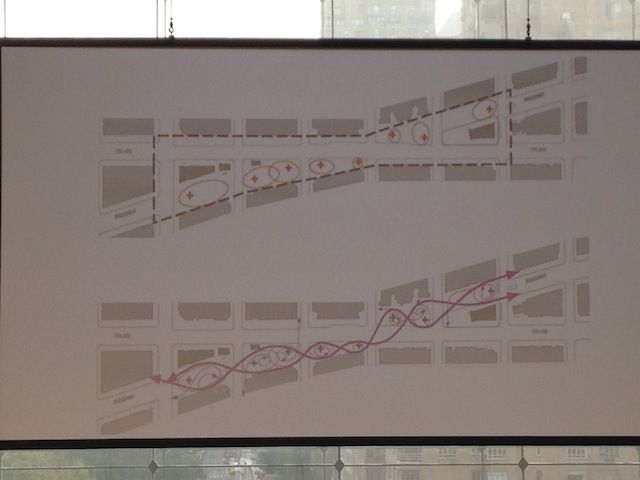
11:16am: Charles Renfro: A Plan for Penn Station as a New Kind of Civic Space
“Penn Station as a new kind of civic space…The West Side of Manhattan is completely different than it was when the old Penn Station was built…Currently MSG and Penn are at odds with each other. We think they should be liberated from each other.” Penn Station could grow into it’s new civic stature if MSG moves near by.
In Europe many new train stations have embraced the idea of a new kind of city…”The new Penn Station should be a city within a city… a 24/7 place… Time is a mode of architectural expression as much as a problem in a train station…the new PS could layer itself from fast to slow vertically, branching and filtering light top to bottom.” The street level passes through as an open civic space.
The plan includes a mobile app with a “time leash” that allows you to not stray too far from where you need to be when you need to be there. “This is new civic architecture where culture and commercial are intertwined.”
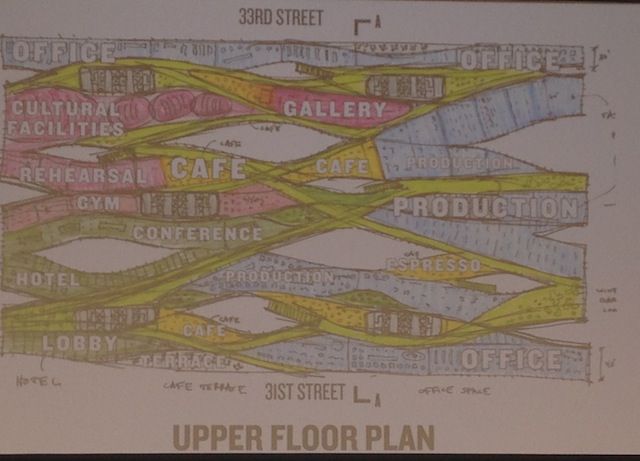
11:06am: Daniel Hernandez on an East Midtown 21st Century Public Realm
“Our pallet was the street system itself.” They aim to re-purpose streets to “represent the aspirations of people.” They surveyed areas of importance on weekdays and weekends.
-A Grand Entrance to NYC: Pershing Square would have four plazas each with an identity. One is a dining, one is pedestrian, one is a transit node, and one is a POP which could be an outdoor meeting place or just a resting place.
-The viaduct would have stairs and an elevator to open it to itself. They would also add balconies which would add vista points to experience the streetscape.
-Park Avenue would have public spaces in the medians which would be winded, be landscaped, and furnished and have sculptures–similar to Broadway on the Upper West Side–but would also have pedestrian North-South paths so one could walk from public median space to public median space.
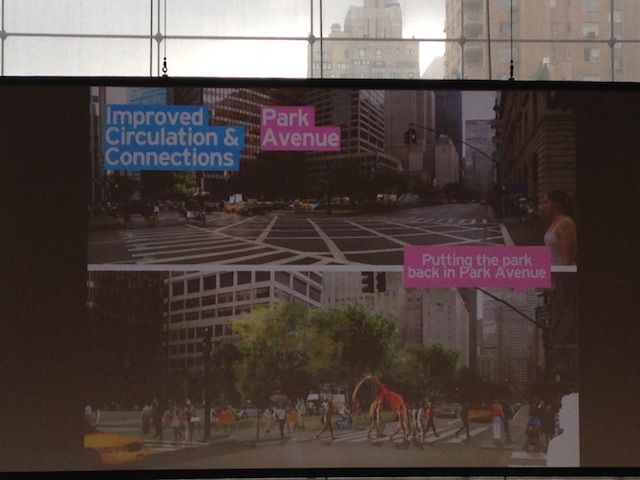
10:45am: Keynote Robert K. Steele, Deputy Mayor for Economic Development on Redeveloping East Midtown
“Ken Jackson aptly wrote that ‘a vital city is a growing city and a growing city is a changing city.’ We believe our plan will be the right kind of change and growth to East Midtown…We are pleased to present you with a community-driven plan for East Midtown. It’s important to consider the Mayor’s plan for East Midtown in the context of NYC’s economy today. There have never been more people living, working, and studying in NYC.”
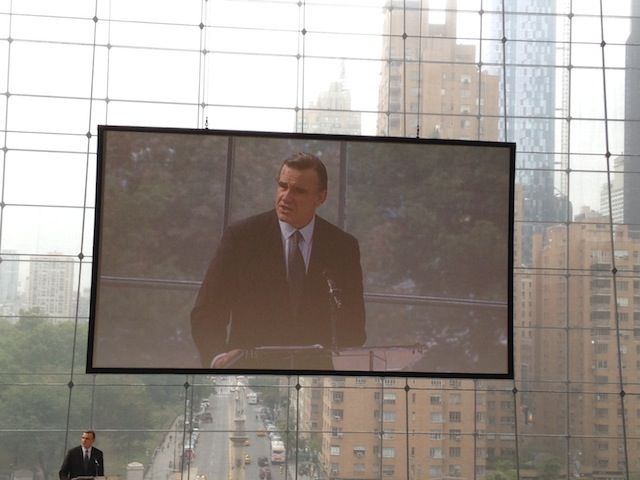
“We have consistently supported adaptive reuse…but we also need new office style, especially in East Midtown which for generations has been the iconic business address… In the last two decades just one new major building has been built in this area.” He believes East Midtown has a substantial shortage of new office space.
Elements of the New Proposal:
-Adjustments to zoning that would encourage a handful of new buildings in the next 20 years
-Participation in the rezoning is limiting to full-block, architecturally significant buildings
-Redevelopment would add only 5% more density which would generate $500 million for new investment
“The details are important and we’ve tried to be good listeners with regard to the feedback we’ve received.” For example adding more mixed-use development per MAS’ recommendation. Another suggestion was made to begin public investment in advance of the development. Bloomberg announced he would pre-fund including improvement of the Lexington station.
The plan aims to also enhance the livability of the neighborhood and re-envision the public realm using three key themes:
-Making Grand Central a more public space: The Grand Central Viaduct should be reclaimed for the public. It ould be a upper level pedestrian terrace. “A new way for pedestrians to experience our city.”
-Details matter: a toolkit of targeted interventions that will enhance the experience of the public realm
-A new connection system between streets and sidewalks.
9:45am: Next Steps for Penn Station with Kenneth Drucker, Design Director, New York Sudio; Maura Moynihan, Founder of Friends of Moynihan Station; Charles Balgi, (moderator) reporter for the New York Times; Hilary Ballon, University Professor Deputy Vice Chancellor, NYU Abu Dhabi; Foster Nichols, Marvin Markus, Managing Director, Goldman Sachs; Robert Yaro, President of the Regional Plan Association
Maura Moynihan: “A New Penn Station would be the kind of project that would define NYC.” Introduces the speakers.
Kenneth Drucker “I want to start off with a question on behalf of every cynical New Yorker… Why should we expect that in 10 years from now we will be any farther ahead than we are now?”
Robert Yaro: “New Yorkers have got to be aggressive for the need for this station. Are we on first base? I guess we’re on first base, maybe second… The station has moved beyond unpleasant to unsafe…it needs to happen. Our job collectively as the business and civic leadership is to keep pounding away on the powers that be…. We have underscored the notion that a new Penn Station could be the focal point for… unlocking the potential of Hudson Yards and the far West Side.”
Hilary Ballon: “It’s the need of the city to recognize the compelling importance of preparing itself for the century ahead… The challenge is to create a sense of fierce urgency… The work MAS has done with the design competition… will drive this project forward. If there isn’t a compelling force to drive it forward…we will sacrifice the future of New York.”
Foster Nichols: There will only be a short window of time to do construction on Penn Station in a cost effective way.
Marvin Markus: “I don’t think you’re on second base. I think you’re up at bat…. The issue comes down to priorities… Everybody knows what the pitch is, the question is, how do you make that a priority financially?”
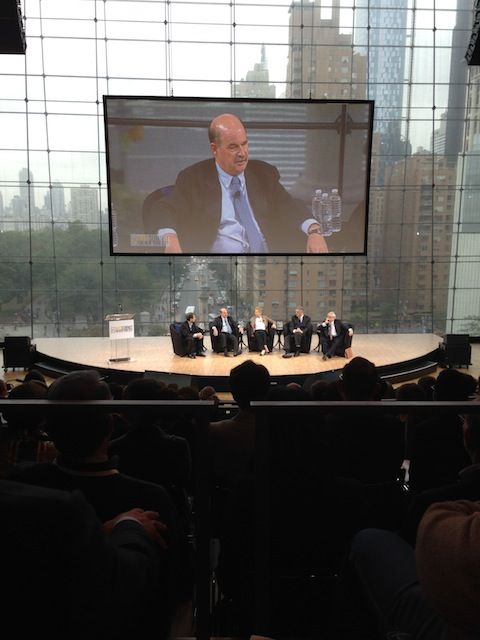
Foster Nichols: “The public interest requires that MSG be moved… not that public interest drives anything in this town.
Charles Bagli: “ZING!”
Robert Yaro: “There’s a lot of devil in the details in working with the railroads and having railroads work together… We should think of all these piees of the puzzle as a complementary solution…to create a facility that is truly productive and magnificent… What we’re doing today is perhaps analogous to decisions made by the Pennsylvania Railroad when they built for a generation a hundred years ago… They could have never envisioned how we use the place today.”
Hillary Ballon: “What is required is unity around the vision!”
Charles Bagli: “Who should lead the public-private partnership?”
Marvin Markus: “Private sector will build if it makes sense! That will be the nature of the partnership. It has to pencil out.”
Foster Nichols: “The railroad interests have to be a critical part of the solution… The integrated full flowering of solution is not something that is possible in the way things are currently structured.”
Marvin Markus: “Well, you have to convince the leadership…convince them it’s a national investment.”
Robert Yaro: “The new mayor coming in is going to be looking at development possibilities and the good news is they guy ahead in the polls at least is a big supporter of making this happen… The Governor needs to see this as THE preeminent development possibility in the State of New York. We’re talking about a dramatic expansion of the tax base. This is the frontier where the next generation of jobs is likely to be created…I think we need to build the case at every level of government.”
Hillary Ballon: “Good design can galvanize the public…New Yorkers have to see that the redevelopment of Penn Station will make their lives better.”
Robert Yaro: “We’re talking about something that’s going to provide value to millions of New Yorkers every day for a century.”
Hillary Ballon reminds us that railroad development began as a private venture but was immediately perceived by the public as a public entity. She says it would be to the benefit of all of the different private rail lines to collaborate.
Robert Yaro: “New York was built on big ideas and big projects… last time we did something as big as this was the redevelopment of Time Square and everyone said we couldn’t do it…. there will be a couple of smarmy political deals…we need to insist that our elected officials deliver the political will and the financing…It’s very doable…. Our competitors are doing it around the world and we need to do it”
Hillary Ballon: “To make a counter-intuitive point, we could also think small… Remember what it feels like to use this station and that will ignite the public.”
9:30am: Phillip K. Howard, Vice Chairman of Covington & Burlington
High speed rail systems are progressing in the US. “We’ve been working on developing a public-private partnership strategy to promote the redevelopment of Union Station.” He wants the project to include an opportunity to connect with the community and create dynamic spaces like the green roof he is developing. For example, Mayor of Annaheim, CA wanted to create an iconic building. He looked at blimp hangers as a model, and created a transparent building that is a high-speed rail connection node. “With train stations the key is to create commuter retail.” He explores different plans for moving Madison Square Garden and how the area will be developed after MSG if removed. How would they improve circulation among different commuter lines? “We all know that we need a new gateway, a new iconic element, a new sense of arrival to NYC.” He believes MSG must move to accomplish this.
9:20am: Keynote Speaker William Helmreich, Professor of Sociology at CUNY Grad Center, author of The New York Nobody Knows
When he was young his father would take him every weekend to the end of the line on different subways and they would walk around. They did it for five years until they ran out of stops. They went to every single stop on every single subway line. That’s how he came to know and love NYC. He walked 6,000 miles through every borough of the city. “It’s the journey, not the destination; that’s what walking is all about.” It forces you to interact with people. He said he’s encountered very few New Yorkers who actually don’t want to talk and interact on the street, in contradiction to the reputation of the city. “If you walk this city you will see a beautiful waterfall deep in the heart of the Bronx that comes out of the Bronx River that is probably half a block wide!” “Obviously it’s very healthy to walk…but please also understand that in addition to the Guggenheim and the Moma and the Met, NYC is the world’s greatest outdoor museum. All you have to do is walk it and you will see what I mean.”
9:16am Eugenie Birch: MAS is now leading the official daily tour of Grand Central, introducing thousands of people to the “secrets and splendors” of that landmark. She welcomes the NYC Urban Fellows to the conference.
9:15am: Edwin Torres: “Building the resilient city cannot just focus on super storms but also challenges we all face on a daily business. We are grateful to MAS for keeping these issues front-of-mind.” Thanks MAS from Rockefeller Foundation.
9:00am: Vin Cipolla, President of MAS’ welcome: “Cities matter and they are the future. Within my children’s lifetimes 75% of the world’s population will live in cities… We’re here to remind our leaders what our cities need: what we need.” He explains that MAS’ main goal is to “provide a forward thinking framework to bring NYC into the future.” MAS is at work to put in place the policies that will ensure livable, resilient cities. “At almost the year-later mark, he says, “as Sandy reminded us, a truly resilient city must be flexible.” “MAS’ works to strengthen communities reinforces the fabric of our city.” Go www.MAS.org for LIVE coverage of the conference.
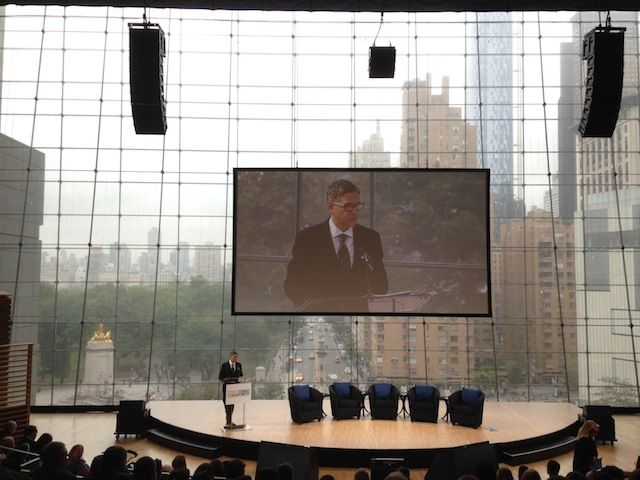
Subscribe to our newsletter